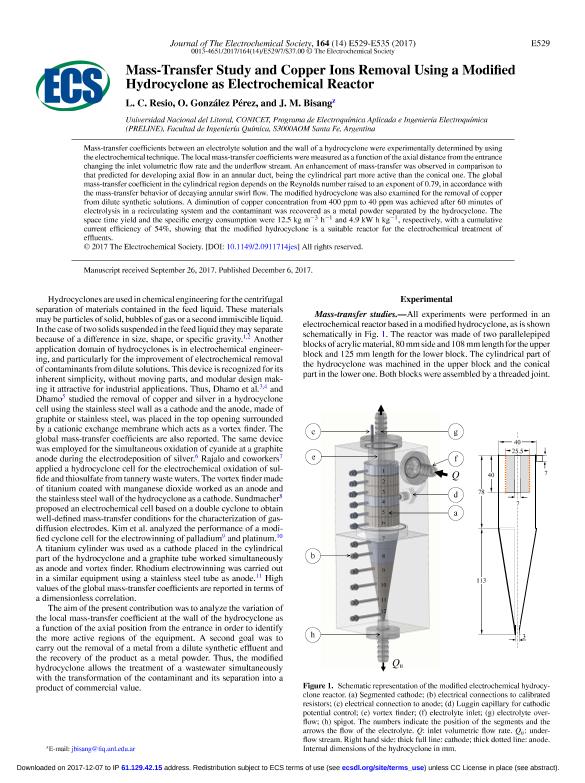Artículo
Mass-transfer study and copper ions removal using a modified hydrocyclone as electrochemical reactor
Fecha de publicación:
01/2017
Editorial:
Electrochemical Society
Revista:
Journal of the Electrochemical Society
ISSN:
0013-4651
e-ISSN:
1945-7111
Idioma:
Inglés
Tipo de recurso:
Artículo publicado
Clasificación temática:
Resumen
Mass-transfer coefficients between an electrolyte solution and the wall of a hydrocyclone were experimentally determined by using the electrochemical technique. The local mass-transfer coefficients were measured as a function of the axial distance from the entrance changing the inlet volumetric flow rate and the underflow stream. An enhancement of mass-transfer was observed in comparison to that predicted for developing axial flow in an annular duct, being the cylindrical part more active than the conical one. The global mass-transfer coefficient in the cylindrical region depends on the Reynolds number raised to an exponent of 0.79, in accordance with the mass-transfer behavior of decaying annular swirl flow. The modified hydrocyclone was also examined for the removal of copper from dilute synthetic solutions. A diminution of copper concentration from 400 ppm to 40 ppm was achieved after 60 minutes of electrolysis in a recirculating system and the contaminant was recovered as a metal powder separated by the hydrocyclone. The space time yield and the specific energy consumption were 12.5 kg m-3 h-1 and 4.9 kWh kg-1, respectively, with a cumulative current efficiency of 54%, showing that the modified hydrocyclone is a suitable reactor for the electrochemical treatment of effluents.
Palabras clave:
Electrochemical Engineering
,
Environment
,
Mass-Transfer
Archivos asociados
Licencia
Identificadores
Colecciones
Articulos(CCT - SANTA FE)
Articulos de CTRO.CIENTIFICO TECNOL.CONICET - SANTA FE
Articulos de CTRO.CIENTIFICO TECNOL.CONICET - SANTA FE
Citación
Resio, L. C.; Gonzalez Perez, Omar; Bisang, Jose Maria; Mass-transfer study and copper ions removal using a modified hydrocyclone as electrochemical reactor; Electrochemical Society; Journal of the Electrochemical Society; 164; 14; 1-2017; E529-E535
Compartir
Altmétricas




